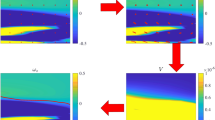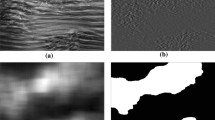Abstract
The experimental analysis of the spatial organization of turbulent/non-turbulent interfaces (TNTI) is an important task in many fields of fluid dynamics, especially to characterize mixing processes. Mixing processes are often associated with the macroscopic motion of coherent flow structures. A classical example for illustration is the turbulent mixing layer visualization by Brown and Roshko (J Fluid Mech 64:775–816, 1974). Today, a question of actual research is if coherent large-scale motions observed in turbulent boundary layer flows have an impact on the structure of the TNTI. As the length of these motions extends over many boundary layer thicknesses and their turbulent energy, and thus significance or impact, raises with Reynolds number, the TNTI detection technique must be accurate at large Reynolds numbers. Furthermore, the technique must be able to resolve the TNTI locally with microscopic spatial resolution and, at the same time, globally over a large macroscopic spatial domain. As the last two points require techniques with a large dynamic spatial range (ratio between largest and smallest scales that can be resolved), only tracer particle-based imaging techniques are suited, as the spatial resolution and field of view (FOV) can both be tuned by adjusting the magnification of the lens and the size and number of camera sensors. In this work, three suited techniques are compared to assess the sensitivity of the TNTI measurement of the method applied. The techniques considered are based on the turbulent kinetic energy, the homogeneity of the non-turbulent flow region, and the particle image density. The effect of bias errors on the TNTI measurement is particularly considered, but the implication of the results for the working range of the various techniques is also outlined. The analysis illustrates exemplary the sensitivity of the intermittency factor and the length of the TNTI with respect to the method applied.
Graphical abstract



















Similar content being viewed by others
References
Anand RK, Boersma BJ, Agrawal A (2009) Detection of turbulent/non-turbulent interface for an axisymmetric turbulent jet: evaluation of known criteria and proposal of a new criterion. Exp Fluids 47:995–1007
Aref H (1984) Stirring by chaotic advection. J Fluid Mech 143:1–21
Bisset DK, Hunt JCR, Rogers MM (2002) The turbulent/non-turbulent interface bounding a far wake. J Fluid Mech 451:383–410
Borrell G, Jiménez J (2016) Properties of the turbulent/non-turbulent interface in boundary layers. J Fluid Mech 801:554–596
Brown GL, Roshko A (1974) On density effects and large structure in turbulent mixing layers. J Fluid Mech 64:775–816
Buchmann NA, Kücükosman YC, Ehrenfried K, Kähler CJ (2016) Wall pressure signature in compressible turbulent boundary layers. In: Progress in Wall Turbulence 2
Chauhan K, Philip J, de Silva CM, Hutchins N, Marusic I (2014) The turbulent/non-turbulent interface and entrainment in a boundary layer. J Fluid Mech 742:119–151
Cierpka C, Kähler CJ (2012) Particle imaging techniques for volumetric three-component (3D3C) velocity measurements in microfluidics. J Vis 15:1–31
Corrsin S (1943) Investigation of flow in an axially symmetrical heated jet of air. Tech. rep., NACA WR W-94
Corrsin S, Kistler AL (1955) Free-Stream Boundaries of Turbulent Flows. Tech. rep., NACA-TR-1244
Dimotakis PE (2005) Turbulent mixing. Annu Rev Fluid Mech 37:329–356
Eckart C (1948) An analysis of the stirring and mixing processes in incompressible fluids. J Mar Res 7:265–275
Falco RE (1977) Coherent motion in the outer region of turbulent boundary layers. Phys Fluids 20:124–132
Fernholz HH, Finley PJ (1996) The incompressible zero-pressure gradient turbulent boundary layer: An assessment of data. Prog Aerosp Sci 32:245–311
Gampert M, Boschung J, Henning F, Gauding M, Peters N (2014) The vorticity versus the scalar criterion for the detection of the turbulent/non-turbulent interface. J Fluid Mech 750:578–596
Ganapathisumbramani B, Clemens NT, Dolling DS (2006) Large-scale motions in a supersonic turbulent boundary layer. J Fluid Mech 556:271–282
Holzner M, Liberzon A, Guala M, Tsinober A, Kinzelbach W (2006) Generalized detection of a turbulent front generated by an oscillating grid. Exp Fluids 41:711–719
Hutchins N, Marusic I (2007) Evidence of very long meandering features in the logarithmic region of turbulent boundary layers. J Fluid Mech 579:1–28
Kähler CJ, Sammler B, Kompenhans J (2002) Generation and control of tracer particles for optical flow investigations in air. Exp Fluids 33:736–742
Kähler CJ, Scholz U, Ortmanns J (2006) Wall-shear-stress and near-wall turbulence measurements up to single pixel resolution by means of long-distance micro-PIV. Exp Fluids 41:327–341
Khashehchi M, Ooi A, Soria J, Marusic I (2013) Evolution of the turbulent/non-turbulent interface of an axisymmetric turbulent jet. Exp Fluids 54
Klebanoff PS (1955) Characteristics of turbulence in a boundary layer with zero pressure gradient. 1135–1153, NACA-TR-1247
Knopp T, Buchmann NA, Schanz D, Eisfeld B, Cierpka C, Hain R, Schröder A, Kähler CJ (2015) Investigation of scaling laws in a turbulent boundary layer flow with adverse pressure gradient using PIV. J Turbul 16:250–272
Krug D, Holzner M, Lüthi B, Wolf M, Kinzelbach W, Tsinober A (2015) The turbulent/non-turbulent interface in an inclined dense gravity current. J Fluid Mech 765:303–324
Kwon YS, Hutchins N, Monty JP (2016) On the use of the Reynolds decomposition in the intermittent region of turbulent boundary layers. J Fluid Mech 794:5–16
Mandelbrot B (1967) How long is the coast of Britain? Statistical self-similarity and fractional dimension. Science 156:636–638
Mathew J, Basu AJ (2002) Some characteristics of entrainment at a cylindrical turbulence boundary. Phys Fluids 14:2065–2072
Meinhart CD, Adrian RJ (1995) On the existence of uniform momentum zones in a turbulent boundary layer. Phys Fluids 7:694–696
Novara M, Schanz D, Reuther N, Kähler CJ, Schröder A (2016) Lagrangian 3D particle tracking in high-speed flows: Shake-The-Box for multi-pulse systems. Exp Fluids 57:128
Poreh M, Cermak JE (1964) Study of diffusion from a line source in a turbulent boundary layer. Int J Heat Mass Transfer 7:1083–1095
Prasad RR, Sreenivasan KR (1989) Scalar interfaces in digital images of turbulent flows. Exp Fluids 7:259–264
Raffel M, Willert CE, Scarano F, Kähler CJ, Werely ST, Kompenhans J (2018) Particle image velocimetry—a practical guide. Springer International Publishing
Richardson LF (1926) Atmospheric diffusion shown on a distance-neighbour graph. Proc R Soc Lond A: Math, Phys Eng Sci 110:709–737
Saxton-Fox T, McKeon BJ (2017) Coherent structures, uniform momentum zones and the streamwise energy spectrum in wall-bounded turbulent fows. J Fluid Mech 826:R6
Sreenivasan KR (1991) On local isotropy of passive scalars in turbulent shear flows. Proc R Soc Lond 434:165–182
Taylor GI (1922) Diffusion by continous movement. Proc London Math Soc
Townsend AA (1948) Local isotropy in the turbulent wake of a cylinder. Aust J Sci Res 1:161–174
Welander P (1955) Sudies of general development of motion in a two-dimensional, ideal fluid. Tellus 7:141–156
Westerweel J, Hoffmann T, Fukushima C, Hunt JCR (2002) The turbulent/non-turbulent interface at the outer boundary of a self-similar turbulent jet. Exp Fluids 33:873–878
Westerweel J, Fukushima C, Pedersen JM, Hunt JCR (2009) Momentum and scalar transport at the turbulent/non-turbulent interface of a jet. J Fluid Mech 631:199–230
Author information
Authors and Affiliations
Corresponding author
Additional information
Publisher's Note
Springer Nature remains neutral with regard to jurisdictional claims in published maps and institutional affiliations
Rights and permissions
About this article
Cite this article
Reuther, N., Kähler, C.J. Evaluation of large-scale turbulent/non-turbulent interface detection methods for wall-bounded flows. Exp Fluids 59, 121 (2018). https://doi.org/10.1007/s00348-018-2576-2
Received:
Revised:
Accepted:
Published:
DOI: https://doi.org/10.1007/s00348-018-2576-2




